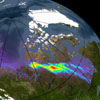Magnetosphere and Auroras
Chandra Looks Back At Earth
A team of scientists observed Earth’s north polar region ten times during a four-month period in 2004. As the bright arcs in this sample of images show, they discovered low-energy (0.1 - 10 kilo electron volts) X-rays generated during auroral activity. Other satellite observatories had previously detected high-energy X-rays from Earth’s auroras.
The images – seen here superimposed on a simulated image of the Earth – are from approximately 20-minute scans during which Chandra was pointed at a fixed point in the sky while the Earth’s motion carried the auroral region through the field of view. The color code of the X-ray arcs represents the brightness of the X-rays, with maximum brightness shown in red.
Auroras are produced by solar storms that eject clouds of energetic charged particles. These particles are deflected when they encounter the Earth’s magnetic field, but in the process large electric voltages are created. Electrons trapped in the Earth’s magnetic field are accelerated by these voltages and spiral along the magnetic field into the polar regions. There they collide with atoms high in the atmosphere and emit X-rays (see the accompanying illustration).
|
||||||||||||||||||||||||






